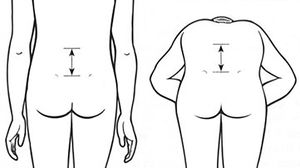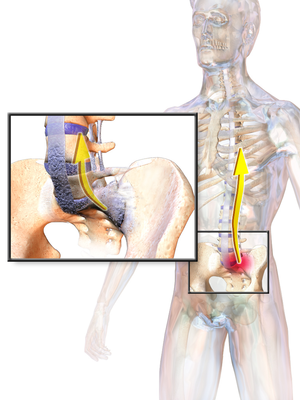Schober Test: Difference between revisions
mNo edit summary |
No edit summary |
||
| (18 intermediate revisions by 6 users not shown) | |||
| Line 1: | Line 1: | ||
<div class="editorbox"> '''Original Editor '''- [[User:User Name|Shauni Van Overstraeten]] '''Top Contributors''' - {{Special:Contributors/{{FULLPAGENAME}}}}</div> | |||
'''Original | |||
'''Top Contributors''' - {{Special:Contributors/{{FULLPAGENAME}}}} | |||
</div> | |||
== Purpose == | == Purpose == | ||
[[File:Schober Test.jpg|right|frameless]] | |||
Schober’s test is classically used to determine if there is a decrease in lumbar spine range of motion (flexion), most commonly as a result of ankylosing spondylitis.<ref name="Rez">Rezvani A, Ergin O., Karacan I., [https://scholar.google.com/scholar_url?url=https://journals.lww.com/spinejournal/FullText/2012/09010/Validity_and_Reliability_of_the_Metric.24.aspx&hl=en&sa=T&oi=gsb&ct=res&cd=0&d=1650841721618701442&ei=MlDnYsOdBI6yyATixq7YDg&scisig=AAGBfm2SoNjSNgSpapsrziAvsnKbarbqSg Validity and reliability of the Metric Measurements in the Assessment of Lumbar Spine Motion in patients with Ankylosing Spondylitis]., 2012, Lippincott Williams & Wilkins, SPINE vol 37, Number 19, pp E1189-E1196 (level of Evidence: 1B)</ref>. | |||
The | The measurement of this test is useful for | ||
* Screening the status of [[Ankylosing Spondylitis (Axial Spondyloarthritis)|ankylosing spondylitis]] disease other spondyloarthropathies. | |||
* Determination of progression and therapeutic effects of ankylosing spondylitis and other pathologic conditions associated with low back pain<ref>Yen YR, Luo JF, Liu ML, Lu FJ, Wang SR. [https://www.ncbi.nlm.nih.gov/pmc/articles/PMC4530222/ The anthropometric measurement of schober’s test in normal taiwanese population.] BioMed research international. 2015;2015.</ref><ref name=":0">Hershkovich O, Grevitt MP, Lotan R. [https://www.ncbi.nlm.nih.gov/pmc/articles/PMC9736537/ Schober Test and Its Modifications Revisited-What Are We Actually Measuring? Computerized Tomography-Based Analysis]. J Clin Med. 2022;11(23).</ref>. | |||
== Technique == | == Technique == | ||
=== Schöber Test === | |||
* Patient is standing, examiner marks the L5 spinous process by drawing a horizontal line across the patient's back. | |||
* A second line is marked 10 cm above the first line. | |||
* Patient is then instructed to flex forward as if attempting to touch his/her toes, examiner remeasures distance between two lines with patient fully flexed. | |||
* The difference between the measurements in erect and flexion positions indicates the outcome of the lumbar flexion <ref name="Rez" />. | |||
== Modifications == | |||
== | === Modified Schober Test === | ||
* Patient is standing, examiner marks both posterior superior iliac spine (PSIS) and then draws a horizontal line at the centre of both marks | |||
* A second line is marked 5 cm below the first line. | |||
* A third line is marked 10 cm above the first line. | |||
* Patient is then instructed to flex forward as if attempting to touch his/her toes, examiner remeasures distance between the top and bottom line. <ref name="Rez" />. | |||
=== Modified Modified Schober Test === | |||
* Patient is standing, examiner marks both PSIS and then draws a horizontal line at the centre of both marks | |||
* A second line is marked 15 cm above the first line. | |||
* Patient is then instructed to flex forward as if attempting to touch his/her toes, examiner remeasures distance between the top and bottom line. <ref name=":0" /> | |||
== | === Wolfson Modified Schober Test === | ||
* Patient is standing, examiner marks both PSIS and then draws a horizontal line at the centre of both marks | |||
* A second line is marked 16 cm above the first line. | |||
* Patient is then instructed to flex forward as if attempting to touch his/her toes, examiner remeasures distance between the top and bottom line. <ref name=":0" /> | |||
== | == Interpretation == | ||
'''Positive Schober’s Test:''' Less than 5cm increase in length with forward flexion: Decreased lumbar spine range of motion, ankylosing spondylitis (Image shows region of spine mainly involved in AS)[[File:AnkylosingSpondylitis.png|frameless|alt=|center]] | |||
== Clinical Notes == | |||
This test is almost exclusively associated with Ankylosing Spondylitis but may also be positive due to a decrease in lumbar range of motion due to pain or congenital anomalies or segmental fusion<ref>Medisavy [https://medisavvy.com/schobers-test/ Schobers Test] Available from:https://medisavvy.com/schobers-test/ (last accessed 30.5.2020)</ref>.{{#ev:youtube|B9RaFB5BwrQ}}<ref>BJC Health Modified Schober's Test for Ankylosing Spondylitis. Available fromhttps://www.youtube.com/watch?v=B9RaFB5BwrQ</ref> | |||
== Evidence == | |||
< | The original Schober Test didn't fully measure the lower back properly. So, they made a modification called the Modified Schober Test. However, even this test couldn't accurately measure the L1-L2 segment. That's why this test is also not highly recommended. They made another modification called the Modified Modified Schober Test, which improved accuracy and became more commonly used for assessing the range of motion in the lower back. However, in a study by Hershkovich, there was still some inaccuracy in including the top part of the lumbar spine. To address this, they made another modification by increasing the measurement by 1 centimeter instead of the usual 15 centimeters. This increased the accuracy rate to almost 100%, but there is a small chance it might also include the segment between the T12 and L1 vertebrae.<ref name=":0" /> | ||
< | {| class="wikitable" | ||
</ | |+'''Spinal segments included in Schober Test and its Modifications<ref name=":0" />''' | ||
! | |||
|'''Original Schober Test''' | |||
|'''Modified Schober Test''' | |||
|'''Modified Modified Schober Test''' | |||
|'''Wolfson Modified Schober Test''' | |||
|- | |||
|'''Segments included''' | |||
|L2/L3-S1 | |||
|L2/L3-S1 | |||
|L1/L2-S1 | |||
|T12/L1-S1 | |||
|} | |||
#Original Schöber Test<br>The validity against radiographs was according to Macrae. strong (r=0.90), according to Rahali-Khachlouf. moderate (r=0.68).<br>The interclass (r=0.90) and intraclass (r=0.96) reliability was found to be excellent<ref name="Rez" />. | |||
#Modified Schöber Index<br>The validity against radiographs was according to Macrae. strong (r=0.97), according to Rahali-Khachlouf. moderate (r=0.59).<br>The interclass (r=0.92) and intraclass (r=0.96) reliability were found to be excellent<ref name="p3">M Tousignant, Poulin L, Marchand S, , [https://scholar.google.com/scholar_url?url=https://www.tandfonline.com/doi/abs/10.1080/09638280400018411&hl=en&sa=T&oi=gsb&ct=res&cd=0&d=12065143981396519582&ei=D1DnYpnZIoakywTS6Y6IDQ&scisig=AAGBfm0-I_3_wLv7wkmO84syuFc_Fe-bow the modified-modified schober test for range of motion assessment of lumbar flexion in patients with low back pain:] a study of criterion validity, intra- and inter-rater reliability and minimum metrically detectable change, disability and rehabilitation, 2005, VOL.27, NO.10, Pages 553-559 (Level of evidence: 4)</ref>. | |||
#Modified-modified Schöber Test<br>The validity of the modified-modified Schober test is moderate (r=0.67) with an excellent interclass (r=0.91) and intraclass (r=95) reliability<ref name="Rez" />.<br> | |||
{{#ev:youtube|eYOUA9asDu8}}<ref>Schober Test for Lumbar Spine Flexion. Available from: https://www.youtube.com/watch?v=eYOUA9asDu8 </ref> | |||
== References == | == References == | ||
<references /> | <references /> | ||
[[Category:Vrije_Universiteit_Brussel_Project | [[Category:Vrije_Universiteit_Brussel_Project]] | ||
[[Category:Outcome Measures]] | |||
[[Category:Lumbar Spine]] | |||
[[Category:Lumbar Spine - Outcome Measures]] | |||
Latest revision as of 08:37, 28 June 2023
Purpose[edit | edit source]
Schober’s test is classically used to determine if there is a decrease in lumbar spine range of motion (flexion), most commonly as a result of ankylosing spondylitis.[1].
The measurement of this test is useful for
- Screening the status of ankylosing spondylitis disease other spondyloarthropathies.
- Determination of progression and therapeutic effects of ankylosing spondylitis and other pathologic conditions associated with low back pain[2][3].
Technique[edit | edit source]
Schöber Test[edit | edit source]
- Patient is standing, examiner marks the L5 spinous process by drawing a horizontal line across the patient's back.
- A second line is marked 10 cm above the first line.
- Patient is then instructed to flex forward as if attempting to touch his/her toes, examiner remeasures distance between two lines with patient fully flexed.
- The difference between the measurements in erect and flexion positions indicates the outcome of the lumbar flexion [1].
Modifications[edit | edit source]
Modified Schober Test[edit | edit source]
- Patient is standing, examiner marks both posterior superior iliac spine (PSIS) and then draws a horizontal line at the centre of both marks
- A second line is marked 5 cm below the first line.
- A third line is marked 10 cm above the first line.
- Patient is then instructed to flex forward as if attempting to touch his/her toes, examiner remeasures distance between the top and bottom line. [1].
Modified Modified Schober Test[edit | edit source]
- Patient is standing, examiner marks both PSIS and then draws a horizontal line at the centre of both marks
- A second line is marked 15 cm above the first line.
- Patient is then instructed to flex forward as if attempting to touch his/her toes, examiner remeasures distance between the top and bottom line. [3]
Wolfson Modified Schober Test[edit | edit source]
- Patient is standing, examiner marks both PSIS and then draws a horizontal line at the centre of both marks
- A second line is marked 16 cm above the first line.
- Patient is then instructed to flex forward as if attempting to touch his/her toes, examiner remeasures distance between the top and bottom line. [3]
Interpretation[edit | edit source]
Positive Schober’s Test: Less than 5cm increase in length with forward flexion: Decreased lumbar spine range of motion, ankylosing spondylitis (Image shows region of spine mainly involved in AS)
Clinical Notes[edit | edit source]
This test is almost exclusively associated with Ankylosing Spondylitis but may also be positive due to a decrease in lumbar range of motion due to pain or congenital anomalies or segmental fusion[4].
Evidence[edit | edit source]
The original Schober Test didn't fully measure the lower back properly. So, they made a modification called the Modified Schober Test. However, even this test couldn't accurately measure the L1-L2 segment. That's why this test is also not highly recommended. They made another modification called the Modified Modified Schober Test, which improved accuracy and became more commonly used for assessing the range of motion in the lower back. However, in a study by Hershkovich, there was still some inaccuracy in including the top part of the lumbar spine. To address this, they made another modification by increasing the measurement by 1 centimeter instead of the usual 15 centimeters. This increased the accuracy rate to almost 100%, but there is a small chance it might also include the segment between the T12 and L1 vertebrae.[3]
| Original Schober Test | Modified Schober Test | Modified Modified Schober Test | Wolfson Modified Schober Test | |
| Segments included | L2/L3-S1 | L2/L3-S1 | L1/L2-S1 | T12/L1-S1 |
- Original Schöber Test
The validity against radiographs was according to Macrae. strong (r=0.90), according to Rahali-Khachlouf. moderate (r=0.68).
The interclass (r=0.90) and intraclass (r=0.96) reliability was found to be excellent[1]. - Modified Schöber Index
The validity against radiographs was according to Macrae. strong (r=0.97), according to Rahali-Khachlouf. moderate (r=0.59).
The interclass (r=0.92) and intraclass (r=0.96) reliability were found to be excellent[6]. - Modified-modified Schöber Test
The validity of the modified-modified Schober test is moderate (r=0.67) with an excellent interclass (r=0.91) and intraclass (r=95) reliability[1].
References[edit | edit source]
- ↑ 1.0 1.1 1.2 1.3 1.4 Rezvani A, Ergin O., Karacan I., Validity and reliability of the Metric Measurements in the Assessment of Lumbar Spine Motion in patients with Ankylosing Spondylitis., 2012, Lippincott Williams & Wilkins, SPINE vol 37, Number 19, pp E1189-E1196 (level of Evidence: 1B)
- ↑ Yen YR, Luo JF, Liu ML, Lu FJ, Wang SR. The anthropometric measurement of schober’s test in normal taiwanese population. BioMed research international. 2015;2015.
- ↑ 3.0 3.1 3.2 3.3 3.4 Hershkovich O, Grevitt MP, Lotan R. Schober Test and Its Modifications Revisited-What Are We Actually Measuring? Computerized Tomography-Based Analysis. J Clin Med. 2022;11(23).
- ↑ Medisavy Schobers Test Available from:https://medisavvy.com/schobers-test/ (last accessed 30.5.2020)
- ↑ BJC Health Modified Schober's Test for Ankylosing Spondylitis. Available fromhttps://www.youtube.com/watch?v=B9RaFB5BwrQ
- ↑ M Tousignant, Poulin L, Marchand S, , the modified-modified schober test for range of motion assessment of lumbar flexion in patients with low back pain: a study of criterion validity, intra- and inter-rater reliability and minimum metrically detectable change, disability and rehabilitation, 2005, VOL.27, NO.10, Pages 553-559 (Level of evidence: 4)
- ↑ Schober Test for Lumbar Spine Flexion. Available from: https://www.youtube.com/watch?v=eYOUA9asDu8








